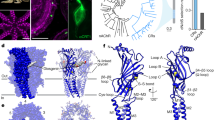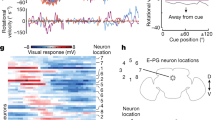Abstract
Neuronal synapses are important microstructures that underlie complex cognitive capacities. Recent studies, primarily in Caenorhabditis elegans and Drosophila melanogaster, have revealed surprising parallels between these synapses and the 'chemosensory synapses' that reside at the tips of chemosensory cells that respond to environmental stimuli. Similarities in the structures, mechanisms of action and specific molecules found at these sites extend to the presynaptic, postsynaptic and glial entities composing both synapse types. In this article I propose that chemosensory synapses may serve as useful models of neuronal synapses, and consider the possibility that the two synapse types derive from a common ancestral structure.
This is a preview of subscription content, access via your institution
Access options
Subscribe to this journal
Receive 12 print issues and online access
$189.00 per year
only $15.75 per issue
Buy this article
- Purchase on Springer Link
- Instant access to full article PDF
Prices may be subject to local taxes which are calculated during checkout



Similar content being viewed by others
References
Kandel, E. R. & Siegelbaum, S. A. in Principles of Neural Science (eds Kandel, E. R., Schwartz, J. H. & Jessell, T. M.) 175–186 (McGraw-Hill, 2000).
Spacek, J. Three-dimensional analysis of dendritic spines. III. Glial sheath. Anat. Embryol. (Berl.) 171, 245–252 (1985).
Ventura, R. & Harris, K. M. Three-dimensional relationships between hippocampal synapses and astrocytes. J. Neurosci. 19, 6897–6906 (1999).
Shaham, S. Glia-neuron interactions in nervous system function and development. Curr. Top. Dev. Biol. 69, 39–66 (2005).
Benton, R., Vannice, K. S., Gomez-Diaz, C. & Vosshall, L. B. Variant ionotropic glutamate receptors as chemosensory receptors in Drosophila. Cell 136, 149–162 (2009).
Mayer, M. L. & Armstrong, N. Structure and function of glutamate receptor ion channels. Annu. Rev. Physiol. 66, 161–181 (2004).
Mayer, M. L. Glutamate receptors at atomic resolution. Nature 440, 456–462 (2006).
Bargmann, C. I. & Horvitz, H. R. Chemosensory neurons with overlapping functions direct chemotaxis to multiple chemicals in C. elegans. Neuron 7, 729–742 (1991).
Nelson, G. et al. An amino-acid taste receptor. Nature 416, 199–202 (2002).
Alioto, T. S. & Ngai, J. The repertoire of olfactory C family G protein-coupled receptors in zebrafish: candidate chemosensory receptors for amino acids. BMC Genomics 7, 309 (2006).
Chandrashekar, J., Hoon, M. A., Ryba, N. J. & Zuker, C. S. The receptors and cells for mammalian taste. Nature 444, 288–294 (2006).
Schwartz, J. H. in Principles of Neural Science (eds Kandel, E. R., Schwartz, J. H. & Jessell, T. M.) 280–297 (McGraw-Hill, 2000).
Yassin, L. et al. Characterization of the deg-3/des-2 receptor: a nicotinic acetylcholine receptor that mutates to cause neuronal degeneration. Mol. Cell. Neurosci. 17, 589–599 (2001).
Alberts, B. et al. in Molecular Biology of the Cell 5th edn (eds Alberts, B. et al.) 619–620 (Garland Science, 2008).
Sambongi, Y. et al. Caenorhabditis elegans senses protons through amphid chemosensory neurons: proton signals elicit avoidance behavior. Neuroreport 11, 2229–2232 (2000).
Beg, A. A., Ernstrom, G. G., Nix, P., Davis, M. W. & Jorgensen, E. M. Protons act as a transmitter for muscle contraction in C. elegans. Cell 132, 149–160 (2008).
Crump, J. G., Zhen, M., Jin, Y. & Bargmann, C. I. The SAD-1 kinase regulates presynaptic vesicle clustering and axon termination. Neuron 29, 115–129 (2001).
Hung., W., Hwang, C., Po, M. D. & Zhen, M. Neuronal polarity is regulated by a direct interaction between a scaffolding protein, Neurabin, and a presynaptic SAD-1 kinase in Caenorhabditis elegans. Development 134, 237–249 (2007).
Dwyer, N. D., Adler, C. E., Crump, J. G., L'Etoile, N. D. & Bargmann, C. I. Polarized dendritic transport and the AP-1 mu1 clathrin adaptor UNC-101 localize odorant receptors to olfactory cilia. Neuron 31, 277–287 (2001).
Margeta, M. A., Wang, G. J. & Shen, K. Clathrin adaptor AP-1 complex excludes multiple postsynaptic receptors from axons in C. elegans. Proc. Natl Acad. Sci. USA 106, 1632–1637 (2009).
Satoh, A. K., O'Tousa, J. E., Ozaki, K. & Ready, D. F. Rab11 mediates post-Golgi trafficking of rhodopsin to the photosensitive apical membrane of Drosophila photoreceptors. Development 132, 1487–1497 (2005).
Brown, T. C., Correia, S. S., Petrok, C. N. & Esteban, J. A. Functional compartmentalization of endosomal trafficking for the synaptic delivery of AMPA receptors during long-term potentiation. J. Neurosci. 27, 13311–13315 (2007).
Rosenbaum, J. L. & Carlson, K. Cilia regeneration in Tetrahymena and its inhibition by colchicine. J. Cell Biol. 40, 415–425 (1969).
Matus, A., Ackermann, M., Pehling, G., Byers, H. R. & Fujiwara, K. High actin concentrations in brain dendritic spines and postsynaptic densities. Proc. Natl Acad. Sci. USA 79, 7590–7594 (1982).
Sekerkova, G., Zheng, L., Loomis, P. A., Mugnaini, E. & Bartles, J. R. Espins and the actin cytoskeleton of hair cell stereocilia and sensory cell microvilli. Cell. Mol. Life Sci. 63, 2329–2341 (2006).
Sekerkova, G. et al. Espins are multifunctional actin cytoskeletal regulatory proteins in the microvilli of chemosensory and mechanosensory cells. J. Neurosci. 24, 5445–5456 (2004).
Flock, A. & Duvall, A. J. The ultrastructure of the kinocilium of the sensory cells in the inner ear and lateral line organs. J. Cell Biol. 25, 1–8 (1965).
Flock, A. & Cheung, H. C. Actin filaments in sensory hairs of inner ear receptor cells. J. Cell Biol. 75, 339–343 (1977).
Perkins, L. A., Hedgecock, E. M., Thomson, J. N. & Culotti, J. G. Mutant sensory cilia in the nematode Caenorhabditis elegans. Dev. Biol. 117, 456–487 (1986).
Ward, S., Thomson, N., White, J. G. & Brenner, S. Electron microscopical reconstruction of the anterior sensory anatomy of the nematode Caenorhabditis elegans. J. Comp. Neurol. 160, 313–337 (1975).
Satterlee, J. S. et al. Specification of thermosensory neuron fate in C. elegans requires ttx-1, a homolog of otd/Otx. Neuron 31, 943–956 (2001).
Bacaj, T., Tevlin, M., Lu, Y. & Shaham, S. Glia are essential for sensory organ function in C. elegans. Science 322, 744–747 (2008).
Jaworski, J. et al. Dynamic microtubules regulate dendritic spine morphology and synaptic plasticity. Neuron 61, 85–100 (2009).
Nimchinsky, E. A., Sabatini, B. L. & Svoboda, K. Structure and function of dendritic spines. Annu. Rev. Physiol. 64, 313–353 (2002).
Yasumatsu, N., Matsuzaki, M., Miyazaki, T., Noguchi, J. & Kasai, H. Principles of long-term dynamics of dendritic spines. J. Neurosci. 28, 13592–13608 (2008).
McEwen, B. S. & Milner, T. A. Hippocampal formation: shedding light on the influence of sex and stress on the brain. Brain Res. Rev. 55, 343–355 (2007).
Li, C. et al. Estrogen alters hippocampal dendritic spine shape and enhances synaptic protein immunoreactivity and spatial memory in female mice. Proc. Natl Acad. Sci. USA 101, 2185–2190 (2004).
Mukhopadhyay, S., Lu, Y., Shaham, S. & Sengupta, P. Sensory signaling-dependent remodeling of olfactory cilia architecture in C. elegans. Dev. Cell 14, 762–774 (2008).
Albert, P. S. & Riddle, D. L. Developmental alterations in sensory neuroanatomy of the Caenorhabditis elegans dauer larva. J. Comp. Neurol. 219, 461–481 (1983).
Swoboda, P., Adler, H. T. & Thomas, J. H. The RFX-type transcription factor DAF-19 regulates sensory neuron cilium formation in C. elegans. Mol. Cell 5, 411–421 (2000).
Senti, G. & Swoboda, P. Distinct isoforms of the RFX transcription factor DAF-19 regulate ciliogenesis and maintenance of synaptic activity. Mol. Biol. Cell 19, 5517–5528 (2008).
Siegelbaum, S. A., Schwartz, J. H. & Kandel, E. R. in Principles of Neural Science (eds Kandel, E. R., Schwartz, J. H. & Jessell, T. M.) 229–252 (McGraw-Hill, 2000).
Buck, L. & Axel, R. A novel multigene family may encode odorant receptors: a molecular basis for odor recognition. Cell 65, 175–187 (1991).
Troemel, E. R., Chou, J. H., Dwyer, N. D., Colbert, H. A. & Bargmann, C. I. Divergent seven transmembrane receptors are candidate chemosensory receptors in C. elegans. Cell 83, 207–218 (1995).
Palczewski, K. et al. Crystal structure of rhodopsin: a G protein-coupled receptor. Science 289, 739–745 (2000).
Kim, E. & Sheng, M. PDZ domain proteins of synapses. Nature Rev. Neurosci. 5, 771–781 (2004).
Tsunoda, S. et al. A multivalent PDZ-domain protein assembles signalling complexes in a G-protein-coupled cascade. Nature 388, 243–249 (1997).
Li, Z., Benard, O. & Margolskee, R. F. Ggamma13 interacts with PDZ domain-containing proteins. J. Biol. Chem. 281, 11066–11073 (2006).
Heiman, M. G. & Shaham, S. Ancestral roles of glia suggested by the nervous system of Caenorhabditis elegans. Neuron Glia Biol. 3, 55–61 (2007).
Peters, A., Palay, S. L. & Webster, H. D. in The Fine Structure of the Nervous System 273–311 (Oxford Univ. Press, 1991).
Todd, K. J. & Robitaille, R. Neuron-glia interactions at the neuromuscular synapse. Novartis Found. Symp. 276, 222–229; discussion 229–237, 275–281 (2006).
Finnemann, S. C. Focal adhesion kinase signaling promotes phagocytosis of integrin-bound photoreceptors. EMBO J. 22, 4143–4154 (2003).
Suzuki, Y., Takeda, M. & Farbman, A. I. Supporting cells as phagocytes in the olfactory epithelium after bulbectomy. J. Comp. Neurol. 376, 509–517 (1996).
Hansel, D. E., Eipper, B. A. & Ronnett, G. V. Neuropeptide Y functions as a neuroproliferative factor. Nature 410, 940–944 (2001).
Nenov, A. P., Chen, C. & Bobbin, R. P. Outward rectifying potassium currents are the dominant voltage activated currents present in Deiters' cells. Hear. Res. 123, 168–182 (1998).
Rio, C., Dikkes, P., Liberman, M. C. & Corfas, G. Glial fibrillary acidic protein expression and promoter activity in the inner ear of developing and adult mice. J. Comp. Neurol. 442, 156–162 (2002).
Brechbuhl, J., Klaey, M. & Broillet, M. C. Grueneberg ganglion cells mediate alarm pheromone detection in mice. Science 321, 1092–1095 (2008).
Mamasuew, K., Breer, H. & Fleischer, J. Grueneberg ganglion neurons respond to cool ambient temperatures. Eur. J. Neurosci. 28, 1775–1785 (2008).
Smit, A. B. et al. A glia-derived acetylcholine-binding protein that modulates synaptic transmission. Nature 411, 261–268 (2001).
Suh, J. & Jackson, F. R. Drosophila ebony activity is required in glia for the circadian regulation of locomotor activity. Neuron 55, 435–447 (2007).
Christopherson, K. S. et al. Thrombospondins are astrocyte-secreted proteins that promote CNS synaptogenesis. Cell 120, 421–433 (2005).
Yoshimura, S., Murray, J. I., Lu, Y., Waterston, R. H. & Shaham, S. mls-2 and vab-3 control glia development, hlh-17/Olig expression and glia-dependent neurite extension in C. elegans. Development 135, 2263–2275 (2008).
White, J. G., Southgate, E., Thomson, J. N. & Brenner, S. The structure of the nervous system of the nematode Caenorhabditis elegans. Philos. Trans. R. Soc. Lond. B Biol. Sci. 314, 1–340 (1986).
Westfall, J. A., Wilson, J. D., Rogers, R. A. & Kinnamon, J. C. Multifunctional features of a gastrodermal sensory cell in hydra: three-dimensional study. J. Neurocytol. 20, 251–261 (1991).
Sakarya, O. et al. A post-synaptic scaffold at the origin of the animal kingdom. PLoS ONE 2, e506 (2007).
Leys, S. P. & Degnan, B. M. Cytological basis of photoresponsive behavior in a sponge larva. Biol. Bull. 201, 323–338 (2001).
Shah, A. S., Ben-Shahar, Y., Moninger, T. O., Kline, J. N. & Welsh, M. J. Motile cilia of human airway epithelia are chemosensory. Science 325, 1131–1134 (2009).
L'Etoile, N. D. et al. The cyclic GMP-dependent protein kinase EGL-4 regulates olfactory adaptation in C. elegans. Neuron 36, 1079–1089 (2002).
Kaye, J. A., Rose, N. C., Goldsworthy, B., Goga, A. & L'Etoile, N. D. A 3'UTR pumilio-binding element directs translational activation in olfactory sensory neurons. Neuron 61, 57–70 (2009).
O'Halloran, D. M., Altshuler-Keylin, S., Lee, J. I. & L'Etoile, N. D. Regulators of AWC mediated olfactory plasticity in Caenorhabditis elegans. PLoS Genet. (in the press).
Bliss, T. V. & Lomo, T. Long-lasting potentiation of synaptic transmission in the dentate area of the anaesthetized rabbit following stimulation of the perforant path. J. Physiol. 232, 331–356 (1973).
Slack, J. R. & Pockett, S. Cyclic AMP induces long-term increase in synaptic efficacy in CA1 region of rat hippocampus. Neurosci. Lett. 130, 69–72 (1991).
Thompson, K. R. et al. Synapse to nucleus signaling during long-term synaptic plasticity; a role for the classical active nuclear import pathway. Neuron 44, 997–1009 (2004).
Mauch, D. H. et al. CNS synaptogenesis promoted by glia-derived cholesterol. Science 294, 1354–1357 (2001).
Fuentes-Medel, Y. et al. Glia and muscle sculpt neuromuscular arbors by engulfing destabilized synaptic boutons and shed presynaptic debris. PLoS Biol. 7, e1000184 (2009).
Colon-Ramos, D. A., Margeta, M. A. & Shen, K. Glia promote local synaptogenesis through UNC-6 (netrin) signaling in C. elegans. Science 318, 103–106 (2007).
Murai, K. K., Nguyen, L. N., Irie, F., Yamaguchi, Y. & Pasquale, E. B. Control of hippocampal dendritic spine morphology through ephrin-A3/EphA4 signaling. Nature Neurosci. 6, 153–160 (2003).
Rothstein, J. D. et al. Knockout of glutamate transporters reveals a major role for astroglial transport in excitotoxicity and clearance of glutamate. Neuron 16, 675–686 (1996).
Adams, R. H. et al. Gene structure and glial expression of the glycine transporter GlyT1 in embryonic and adult rodents. J. Neurosci. 15, 2524–2532 (1995).
Minelli, A., DeBiasi, S., Brecha, N. C., Zuccarello, L. V. & Conti, F. GAT-3, a high-affinity GABA plasma membrane transporter, is localized to astrocytic processes, and it is not confined to the vicinity of GABAergic synapses in the cerebral cortex. J. Neurosci. 16, 6255–6264 (1996).
Araque, A., Parpura, V., Sanzgiri, R. P. & Haydon, P. G. Glutamate-dependent astrocyte modulation of synaptic transmission between cultured hippocampal neurons. Eur. J. Neurosci. 10, 2129–2142 (1998).
Heumann, R., Villegas, J. & Herzfeld, D. W. Acetylcholine synthesis in the Schwann cell and axon in the giant nerve fiber of the squid. J. Neurochem. 36, 765–768 (1981).
Minchin, M. C. & Iversen, L. L. Release of (3H)gamma-aminobutyric acid from glial cells in rat dorsal root ganglia. J. Neurochem. 23, 533–540 (1974).
Newman, E. A. Glial cell inhibition of neurons by release of ATP. J. Neurosci. 23, 1659–1666 (2003).
Oliet, S. H. & Mothet, J. P. Regulation of N-methyl-D-aspartate receptors by astrocytic D-serine. Neuroscience 158, 275–283 (2009).
Acknowledgements
I would like to thank J. Darnell, M. Heiman, M. Nedergaard and L. Vosshall for comments and discussions of the ideas presented here and R. Benton and Y. Lu for sharing images. This work was supported in part by US National Institutes of Health grant R01NS064273.
Author information
Authors and Affiliations
Ethics declarations
Competing interests
The author declares no competing financial interests.
Related links
Rights and permissions
About this article
Cite this article
Shaham, S. Chemosensory organs as models of neuronal synapses. Nat Rev Neurosci 11, 212–217 (2010). https://doi.org/10.1038/nrn2740
Published:
Issue Date:
DOI: https://doi.org/10.1038/nrn2740
This article is cited by
-
Keeping pace: the primary cilium as the conducting baton of the islet
Diabetologia (2024)
-
Functional properties of insect olfactory receptors: ionotropic receptors and odorant receptors
Cell and Tissue Research (2021)
-
Co-option of neurotransmitter signaling for inter-organismal communication in C. elegans
Nature Communications (2019)
-
The more we know, the more we have to discover: an exciting future for understanding cilia and ciliopathies
Cilia (2015)
-
Mechanisms underlying odorant-induced and spontaneous calcium signals in olfactory receptor neurons of spiny lobsters, Panulirus argus
Journal of Comparative Physiology A (2014)



